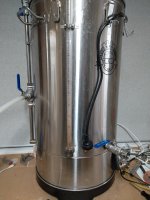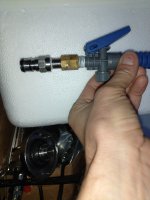So I've been lurking here for quite a while, I Brewed for about 10 years, made the usual progression from extract, then added steeping grains, and stepped up to all grain. Work and family took priority, brewing took a back seat, about 10 to 15 extract batches over the next 10 years.
Started back into it during the lockdown. I got the 35L Brewzilla about 6 months ago. I have an idea or two about the sight tubes.
Rather than getting a bigger saddle, I would use 2 thin washers underneath the saddle, this will give you some breathing room for the sight tube.
I didn't buy a sight tube yet. I was thinking of an alternative option. My plan is to take the stainless tube off and cut it about an inch from the 2 fittings. Then replace that piece with some high temp silicone tubing using hose clamps.
Before I take a saw to the stainless, I thought I would post it here and see if I am missing something. If there is a fatal flaw, Please point it out.
Thanks
























































![Craft A Brew - Safale S-04 Dry Yeast - Fermentis - English Ale Dry Yeast - For English and American Ales and Hard Apple Ciders - Ingredients for Home Brewing - Beer Making Supplies - [1 Pack]](https://m.media-amazon.com/images/I/41fVGNh6JfL._SL500_.jpg)



